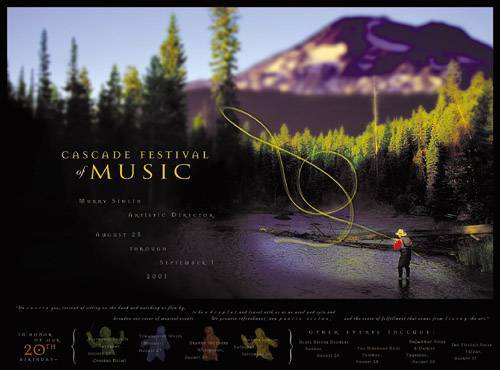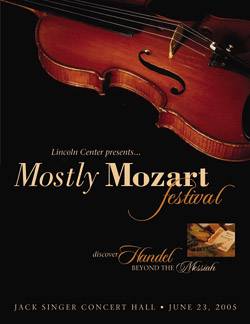Poster Design Project
| Throughout this chapter, you learned how to direct the viewer's attention using a variety of compositional techniques. Now you'll use this knowledge to design an event poster that interests and informs. Your client is giving you a lot of creative freedom for the poster, so use it wisely. Consider methods for getting the message across economically with a killer composition and use of typography. Project Brief: Mozart FestivalYou have been commissioned to design a poster for a touring Mozart festival that's visiting your city. The festival, which originated at New York's Lincoln Center for the Performing Arts, celebrates the compositions of Mozart plus a few other classical music icons such as Beethoven, Schubert, and Haydn. Your client would like an effective poster design that captures the sophisticated but fun spirit of the festival. The poster will be displayed outside your town theater, so it must be designed to be viewed from a distance. Pedestrian passersby will see it, as will commuters on bikes and in cars. Figure 6.26. Arts organizations like New York's Lincoln Center for the Performing Arts rely on posters to advertise a multitude of events and performances to passersby.
The festival is aimed at classical music fans, who are typically older and more affluent, but organizers are also hoping to get a younger crowd interested in classical music. The dimensions of the poster are 20 inches wide by 30 inches tall, to fit in a vertical marquee, but for the purposes of this project you may scale it down to 10 inches wide by 15 inches tall, or 4 by 6. The copy should read: The New York Traveling Orchestra presents: Mozart Festival Discover Mozart, Beethoven, and more [insert your local venue name] [insert a date of your choice] Project Summary
STUDIO SESSIONS www.studiosessions.net/portfolio Post this chapter's project online for feedback from professional designers. access code: STUDIOp Project StepsLike every good design project, this one will start with some research and conceptualizationthen it's onto your creative composition. 1. Research the Subject and LocationUnless you're quite the classical music aficionado, you'll need to spend some time understanding the graphic style typically used in this genre. CD covers, Web sites, other classical music event postersall of these should be part of your research. Ask yourself some questions as you work:
As you view the artwork, try to put yourself in the shoes of a typical member of the target audience, and consider the location of the poster outside the theater. If you can, visit a theater in your area to see what environmental features may enhance or get in the way of your poster. For example, if the theater's exterior is red brick, you may want to stay away from a dark red main color so as to keep the poster from blending in too much. Figure 6.27. This poster for the Cascade Festival of Music has a goal similar to that of your poster project, and achieves it with balanced composition, text with a rhythmic beat, and an image that suggests both the location and the music.
2. Conceptualize and Find ImagesWith research in hand, plan a concept that integrates your city and the Mozart/classical music theme. And don't forget the audience! How will you design your poster to reach true classical music fans as well as energize young newcomers? As you conceptualize, don't worry too much about specifics. For now, just get a sense of the direction and tone you think your poster should take, what types of colors and images are appropriate, and how you can get the message across quickly within its environment. From here, you can begin finding the images you plan to use, if any. (A text-based design is perfectly valid, too, as long as it is effective.) If possible, take your own photos or make your own illustrationsbut you may use other sources for your images as you see fit. 3. Sketch Out Your CompositionIf your concept is developed and you know which text and images you will use, you can plan your composition. Decide which part of the design is the focal point, how you will move the viewer through the design, and how you will create a hierarchy of information. Before you begin, review the techniques for unity, balance, rhythm, and proportion. Start sketching while you consider the following:
4. Produce Your ArtworkDon't confine yourself here. Begin on a fresh Photoshop canvas in the size you'd like to work with (4" by 6", 10" by 15", or the actual size of 20" by 30", which is great for your portfolio), and produce your background elements. To help you along, you may want to overlay a grid on your canvas (View > Show > Grid), or show the document rulers (View > Rulers). With background elements in place (colors, patterns, geometric areas, and so on), you can bring in your photographs or illustrations. If you need to edit them or clean them up, do that first, and then position them according to the composition decisions you made. Nothing is set in stonetake a step back and see if this composition truly gets your point across in the best way possible. Simple tweaks to the placement, value, or size of your images can often turn an off-kilter layout into a more balanced one. 5. Incorporate TypographyNow you can add your typography. As you set all of the wording supplied by the client, consider the virtues we discussedsimplicity, balance, and placement. How will you make the text easy to read (but still interesting!), balance it with other elements, and be sure it is appropriate to the public placement of your poster? Choose your typefaces carefully, remembering to stick to just a couple and to go decorative only when appropriate. And don't forget the personality of your type and how it works within your overall composition scheme. Will it engage audiences young and old? Will it give the festival the appropriate tone? Is the hierarchy clear? 6. Review Your WorkMake any final tweaks that you feel are appropriate, and then take a step back and look at your work. How do the shapes relate to each other? Is your design unified and balanced? Do you feel a sense of rhythm? Is there a clear focal point? Good; now you are ready to present your work to the client! If you want to go one step further, why not adapt your composition to a horizontal format? Suppose it will be used for advertisement on the side of a bus. The dimensions should be 12" by 4" for this optional project. Student WorkHere are some sample posters from Sessions students with a similar music project: Figure 6.28. Hammad Iqbal creates a strong balance in his muted, sophisticated composition, and keeps the text simple and clean against the detailed photography.
Figure 6.29. Wilbert Reddit makes some great type choices in this poster. Notice the interesting negative space created by the outline of the violin.
Figure 6.30. Ulf Finndahl's poster uses a large, simplified photo to balance perfectly with the smaller, more detailed photo and typography. Also notice how the violin itself leads the eye.
|
EAN: 2147483647
Pages: 103




